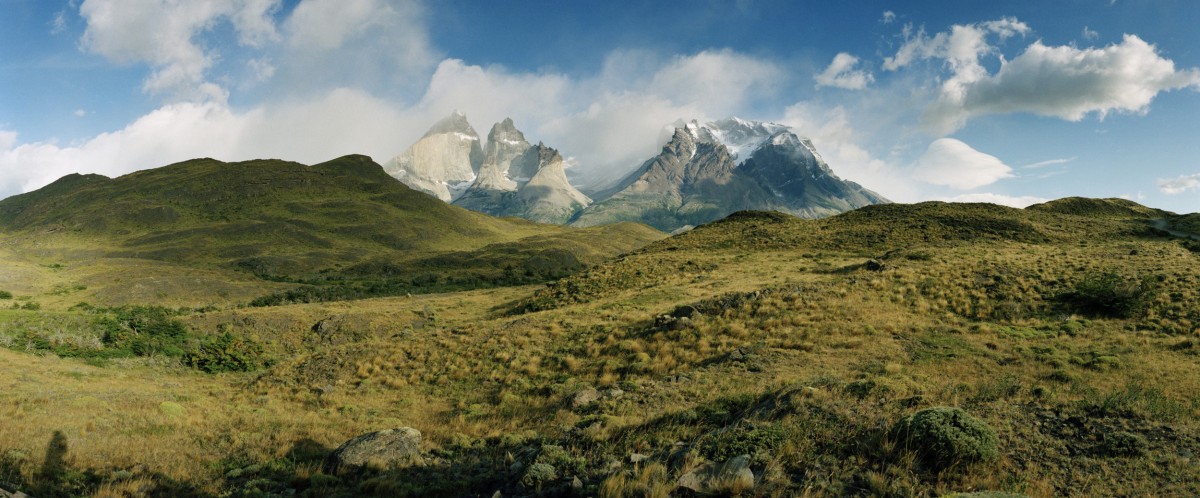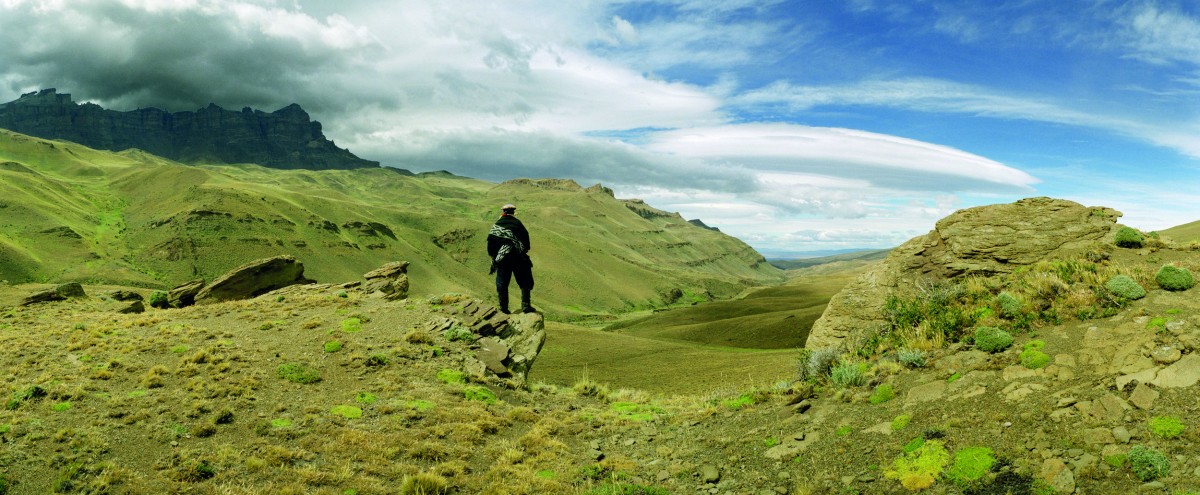Coming in for the landing at Punta Arenas, mainland South America’s southernmost city, the plane dips low over the Strait of Magellan, so close that I can see whitecaps tearingacross the storied waterway toward Tierra del Fuego. On the ground, gale-force winds nearly blow me over as I flee the tiny airport terminal.
The road from Punta Arenas to the mountains runs across vast, windswept plains—the fabled pampas. It takes us through kilometer after kilometer of dun-colored grasslands broken only by the occasional windmill or a knot of sheep huddled against the unrelenting wind. Every so often a sign points the way up a dirt road to a secluded estancia. Most of these estates remain working ranches, but a few now open their doors to travelers for daytime visits and overnight stays.
At Estancia Cerro Guido, I go horseback riding with a couple of gauchos, galloping across the pampas for an hour and then joining them for a dinner of roast lamb straight off the spit. Patricio Varcaza, the older of the two, is deeply tanned with a weathered face etched by four decades of outdoor life. “I’ve been riding horses since I was six or seven years old,” he tells me. “Working with horses and cows and sheep—it’s a hard life, yes. But when I started out, it was even more difficult. Back then we did not have trucks or radios. But even with these modern things it’s still the same work. You need to move the animals in rain, wind, or snow, whatever the weather.”
I ask him about his outfit: the red beret, the green scarf, the sash around his waist. “It’s kind of like a black belt in karate,” he laughs. “A gaucho must earn these three things by being a good rider.” Varcaza earned his by riding bucking broncos in local jineteadas (rodeos) and winning 50-kilometer endurance races across the pampas. “The winner,” he explains, “is not the fastest horse, but the one that’s in best condition at the end. The calmest horse is the champion, not the first one across the finish line.”
By nightfall I’ve checked in to Tierra Patagonia, a new 40-room lodge on the edge of Torres del Paine National Park. The following morning, curled up next to my window, I watch the dawn break over the park’s eponymous peaks. It doesn’t disappoint. From a soft alpenglow, the mountains slowly take on the blazing gold of sunrise and then the purply-blue hue that gives the massif its name—paine, it turns out, has nothing to do with physical discomfort; it means “blue” in the language of the Tehuelche, a nomadic people who once called this region home.
Daylight also gives me a chance to explore the lodge, a mosaic of wood, glass, and stone designed by three of Chile’s leading architects. You hardly notice the low, elongated structure when approaching from the south, that’s how well it blends into the rolling pampas. Everything inside the lodge, including its glass-enclosed swimming pool, is designed to maximize views of the jagged peaks on the other side of Lake Sarmiento. But there are also interesting things close at hand, like the flock of flightless rhea munching the golden-brown grass just beyond the front door. A trail leads from the back of the lodge down a bluff to the lake. With a hypersaline environment that attracts flamingoes and fosters colonies of coral-like thrombolites, Lake Sarmiento is a natural wonder all on its own.
But mountains are what it’s all about down here and I am eager for a closer look. Over the next few days I take several hikes inside the park with guides from Tierra Patagonia. But the one that blows my mind is a trek along the so-called Hunters Trail with locally born and raised nature expert Felipe Zúñiga. I assume that the route is named for human predators, perhaps the same Indians who so eloquently described the peaks. But Zúñiga quickly sets me straight; the “hunters” in this case are the puma that frequent this corner of the park. I don’t expect to see big cats during the daytime, but there are plenty of signs of their nocturnal activities, from nuggets of scat to the remains of a half-eaten guanaco. It isn’t long before we come upon the first of many herds of guanacos, cousins to the llama. “When the Spanish first arrived there were something like 30 to 50 million guanacos in Patagonia,” Zúñiga says. “They were almost hunted to extinction; today there’s only about half a million or so. But now they are protected and some people are even trying to raise them like sheep or cattle.”
The guanacos seem to have no fear of us, stepping casually aside as we move through the middle of the herd. But that is true of all the animals we come across on the trail that day, including little red foxes and ostrich-like rheas. Even before Torres del Paine National Park was established in 1959, the area was so remote that few people came this way. And those who did didn’t stay long because the conditions—especially the wind and cold—were just too extreme. Few places on earth are so pristine.
Scrambling up a final ridge, we come face-to-face with the sheer blue granite of the Torres del Paine’s three main towers. Shaped over the eons by glacial forces, they’re incredibly lean and angular; one early English visitor dubbed them “Cleopatra’s Needles.” They’re also very, very tall, rising almost 2,000 meters from where we are standing into an ever-changing swirl of cloud and light. Dumbstruck, I just sit there, gaping upward and thinking that sometimes it can take a long time to reach your destination. Decades, in this case. But it was worth the wait.
THE DETAILS
GETTING THERE
From Southeast Asia and Hong Kong, the shortest route to Santiago is via Sydney with Qantas or via Auckland with Cathay Pacific and code-share partner LAN. There are daily flights from the Chilean capital to Puerto Natales or Punta Arenas in the south; for those wanting to experience some of Chile’s jigsaw-puzzle coastline, Navimag Ferries offers one-night sailing between Puerto Montt and Puerto Chacabuco, with cabins going for US$246.
WHEN TO GO
Santiago, with its mild Mediterranean climate, can be pleasant to visit throughout the year. Not so Chilean Patagonia: unless you’re a fan of extreme weather, the southern region should be avoided in winter (June–August), when temperatures are often below freezing and rain or snow is a daily occurrence. Summertime (December–February) is definitely the best time to visit Chile’s south; even then, pack a wardrobe that ranges from shorts and T-shirts to waterproof jacket, wooly hats, and gloves.
WHERE TO STAY
Santiago’s increasingly sophisticated hotel scene includes the chic Aubrey (Constitución 299–317; 56-2/940-2800; doubles from US$240) in artsy Bellavista, just down the street from the former weekend house (now a museum) of Chilean poet laureate Pablo Neruda. Those who prefer mainstream luxury can opt for the Ritz-Carlton, Santiago (15 Calle El Alcalde; 56-2/2470-8500; doubles from US$279) in the swish Los Condes area. Torres del Paine National Park offers half a dozen upscale wilderness lodges, none better than Tierra Patagonia (56- 2/2370-5301; three nights from US$2,250 per person, double, all-inclusive). In addition to gourmet Patagonian cuisine, the hotel boasts a spa with an indoor swimming pool and a full slate of guided day trips.
Across the steppe to the east of the park, Estancia Cerro Guido (56-61/236-0305; doubles from US$200) offers a taste of authentic rural life, with cozy ranch-house accommodation and seasonal activities including shepherding and horseshoeing.
This article originally appeared in the August/September 2013 issue of DestinAsian (“Passage to Patagonia”)









